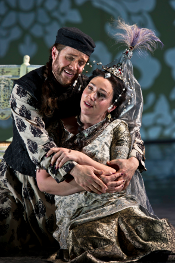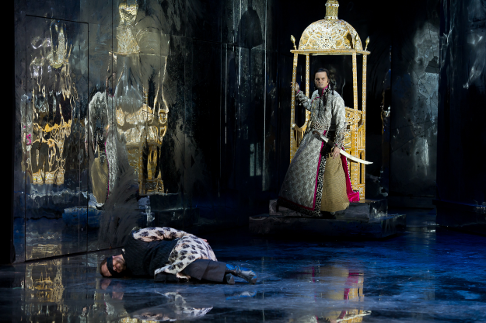10 Oct 2010
Technicolour Radamisto at ENO
Handel’s Radamisto came to the ENO at the Coliseum in glorious technicolour.

Handel’s Radamisto came to the ENO at the Coliseum in glorious technicolour.
Images of Asia proliferate polygamously — Mughal India, Tokugawa Japan, and Chinese restaurant chic, tumbled randomly together. The text, of course, mentions Armenia. Visual indigestion, if you’re culturally aware. But to Handel and his audiences, specifics didn’t matter. Radamisto is a morality tale which transcends time and place.
Tiridate (Ryan McKinny) lusts for Zenobia (Christine Rice) who’s happily married to Radamisto (Lawrence Zazza). To win her he’ll drop his wife Polissena (Sophie Bevan) and usurp Farasmane’s kingdom (Henry Waddington). But Zenobia’s having nothing of it. She’d rather die than be unfaithful. Subplots and complications (they’re all family, for example) are decorative embellishments. The basic message is surprisingly simple: love overcomes all.
This fundamental chastity pervades the whole opera. Structurally, it’s very tight. In neat succession, set piece arias follow one another, allowing each singer to display his or her vocal virtuosity.Simplicity of form, allowing inventive elaboration without blurring the basic line. Much like the set designs. Despite being floridly over the top, these designs are much more minimal than appear at first.
 Christine Rice as Zenobia and Lawrence Zazzo as Radamisto
Christine Rice as Zenobia and Lawrence Zazzo as Radamisto
Lawrence Zazzo’s Radamisto is superb. His tessitura isn’t forced but
flows well, carefully modulated and well-judged, important in a role which
stresses integrity. The extended rhapsody on honour is particularly striking,
decorations extending each word, yet flowing naturally, without affectation.
You marvel at the inventiveness, but also meditate on meaning. Honour does
matter, Radamisto keeps saying as he and Zenobia amply demonstrate. These
aren’t just “words”, dwelling on them serves a moral as well as artistic
purpose.
The contrast between Radamisto and Tiridate is enhanced counterbalancing Zazzo’s countertenor with Ryan McKinny’s bass-baritone. In baroque, low voices often signify villains, but McKinny doesn’t overdo the inherent power in his voice. Instead he relies on subtle expression, using agile legato. In any case, refinement enhances the role. Tiridate holds a sword poised to kill Radamisto, but the long, lyrical elaboration deflects the menace, Reality, in Handel, is deeper than it seems on the surface.
Christine Rice is exquisitely dignified and gracious. In Carmen, she seemed inhibited, and even as Ariadne in Birtwistle’s The Minotaur she didn’t access the kinkier aspects of the role. As Zenobia, however, she’s ideal. Her patrician reserve perfectly fits the role, so she can create Zenobia’s compelling beauty with her voice. Sophie Bevan’s Polissena and Henry Waddington’s Farasmane impressed too. Ailish Tynan’s Tigrane reached notes higher than might be expected.
 Scene from Radamisto
Scene from Radamisto
So what was my biggest misgiving about this production? David Alden depicts Tigrane as a grotesque, a camp cross between Sidney Greenstreet and King Farouk, but for no conceivable purpose. Is he trying to inject comic humour? Perhaps it works in a grubby sort of way but it jars with the noble import of this opera. The whole point, for Handel, was to edify. The idea of morality trouncing tyranny was inherently racy in a time when absolute monarchy still held sway. Besides, Tigrane is arguably a hero since it’s he who selflessly resolves matters. This portrayal is misogynistic and homophobic, completely pointless. Admittedly it was part of the 2008 Santa Fe premiere but it’s still deeply offensive and should be dropped.
What Alden lacks in sensitivity, Laurence Cummings made up for with the orchestra, who played with brio under his direction.
Anne Ozorio